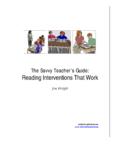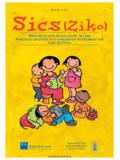Transcription of Intervention Programming for Nonverbal Children …
1 IInntteerrvveennttiioonn PPrrooggrraammmmiinngg ffoorr NNoonnvveerrbbaall CChhiillddrreenn BBrreennddaa AAddddiinnggttoonn,, MMAA CCCCCC--SSLLPP 6020 Old Richmond Road Lexington, KY 40515 (859) 552-8356 e-mail: website: Copyright: Brenda Addington, 2009. For permission to re-print, please contact: Today s Purposes Comfort Zones, Finding Joy! Considering differing needs of non-verbal kids Determining Starting points with non-verbal kids Intervention Programming A KDG frame of Mind Start with a framework for decision making Programming Ideas from the Kindergarten classroom Relationship Building with students and teachers Repetition over time Creating a world of wonder WOW FFrraammeewwoorrkk ffoorr NNoonnvveerrbbaall DDeecciissiioonn MMaakkiinngg Nonverbal Challenges Speech is speech Ignored recommendations defeat the purpose of therapy
2 Misunderstanding of our roles Underutilized in the school setting Creating the communication friendly setting outside of therapy Trust in decision making Our Roles Dispelling the speech is speech philosophy Integrate communication with all activities Assist in creating the communication friendly classroom Assist in daily Programming activities Avoid isolationism Nonverbal -FC Flowchart Created based on my challenges Streamline Evaluation Expedite Decision Making Consistent Procedures Promotes understanding of roles Non-Verbal Flowchart Basis Unintelligible Speech Absence of Language Or absence of speech Very low verbal Possible Etiologies Apraxia Autism Phonological Stroke & Neurological Dysarthria Syndromes Stroke & Neurological TBI TBI Unknown etiology Locked in syndromes Assessment: SETT framework (Zabala 1 996) Student.
3 Gather information regarding student s current mode of communication, cognitive ability, attention, behavior, pragmatics, physical capability and complexity of communication. Environments: observe the student across does the student need to communicate? Tasks: look at tasks, academic activities and basic skills. What does student need in order to communicate in current educational Programming ? Tools: Based on the information provided above, determine the tools that will best fit the student s needs that will be usable across settings and that others will implement Main Goals Provide an interim device/means Establish a means of communication of communication while determining that meets the child s cognitive and if speech can be a viable means of physical capabilities communication Skill Development Hierarchy Device Usage and Care Attention/Listening/Behavior Sign/Gestures Determine mode of communication
4 Functional utterances: Personal & Scripts Cause-Effect: switch, sign, pix, vocal Speech Sounds Pragmatics/Communication Behavior Personal Information Functional Utterances-Scripts Underlying vocabulary deficits Concept Development-Vocabulary Enhance Reading and Writing Skills Personal Information Flowchart paths Evaluation route is the same for both paths Type of Nonverbal student determines the treatment goals Therapy may be similar if using a
5 Kindergarten Programming approach! Why Consider FC for Articulation? Decrease student s frustration Eliminate guessing about the message Improve response from others Improve student s participation Increase student s independence Improve socialization skills A word Locked-in Syndromes How to tell: Easy to get a consistent yes/no response Compliance Reliable Willingness to duplicate responses Others tell SLPs the person is locked in when it s really absence of language SETT framework Joy Zabala (1996) Designed to encompass aspects of AT evaluations, this guide can be adapted for non-verbal evaluation Helps organize and maintain focus Systematic collection of information through observation, interview and interaction Observation Key tool of SETT Main goal.
6 Look for any type of communicative behavior Observe student in several settings to learn as much about the student as possible Gathering Information Look for anyone who has prior experience with the student Talk to teachers---determine their concerns and expectations Research what has been tried before Tip: don t be quick to change Present level of Communication A mode of communication Vocalization/speech hand gestures eye movement facial expressions picture usage Effectiveness of the current system Milestone Checklists Birth to five speech and language checklists Determine a functional language level Gauge cognition based on checklists Mayo Clinic Checklist Language and Cognition Receptive Language Tests: Consider tests in cases of.
7 Locked-in syndrome Severely impaired speech Alternate mode of communication in use Find a general cognitive level Cognitive Status Will dictate the complexity of a system Provides an impression of what typical activities of daily living might be Will determine the types of vocabulary to be incorporated into a system Physical Capabilities & Mobility Issues Dictates the mode of communication Point of access Portability Ease of use Determines if speech is a viable mode of communication Impeding Factors determines whether an alternative mode will be incorporated into the client s daily life Family barriers Staffing barriers Environmental barriers Student barriers attention, behavior ABC s of communication Attention and Behavior must precede developing a foundation for Communication Use observation to determine: Is the student attending to activities and people?
8 Does the student have self control of behavior? If attention or appropriate behavior is not present, there lies the focus of any educational Programming Therapy is going to be geared to gaining and maintaining attention If behavior is a Is negative behavior being used as a mode of communication? Has the student communicated needs and then protests when need is not taken care of? Is there consistency with behavioral expectations across settings? Two Solutions Providing the tools for communication and teaching the student to use those tools can reduce or eliminate using behavior as a mode of communication Providing consistent behavioral Programming is necessary to eliminate aggressive behavior when a communication system is in place The trick.
9 Make conventional communication more appealing than the behavior mode as a means to communicate As long as the student is getting needs met with behavior, the behavior will continue Pragmatics Pragmatics is the foundation for communication ability to participate in an interaction precedes any ability to access a communication system Look for evidence of turn taking, requesting, responding verbally, greeting, eye contact, etc. (Prutting) Does the student understand they are in a communication interaction? Can they initiate communication?
10 If they do initiate, how does that happen? Are there some undesirable or physical behaviors that need to be extinguished first? If the student is not demonstrating pragmatic skills consistently, this is the therapy focus Once the student demonstrates pragmatic skills move on to vocabulary or developing a more complex communication system Social Interaction Give serious consideration to social Foundation for communication Quality of life Determines leisure activities Determines vocabulary levels Determines complexity of system The student will reveal the mode that works best for them Our job is to figure out how to improve what is currently in place Then get everyone working toward getting the




